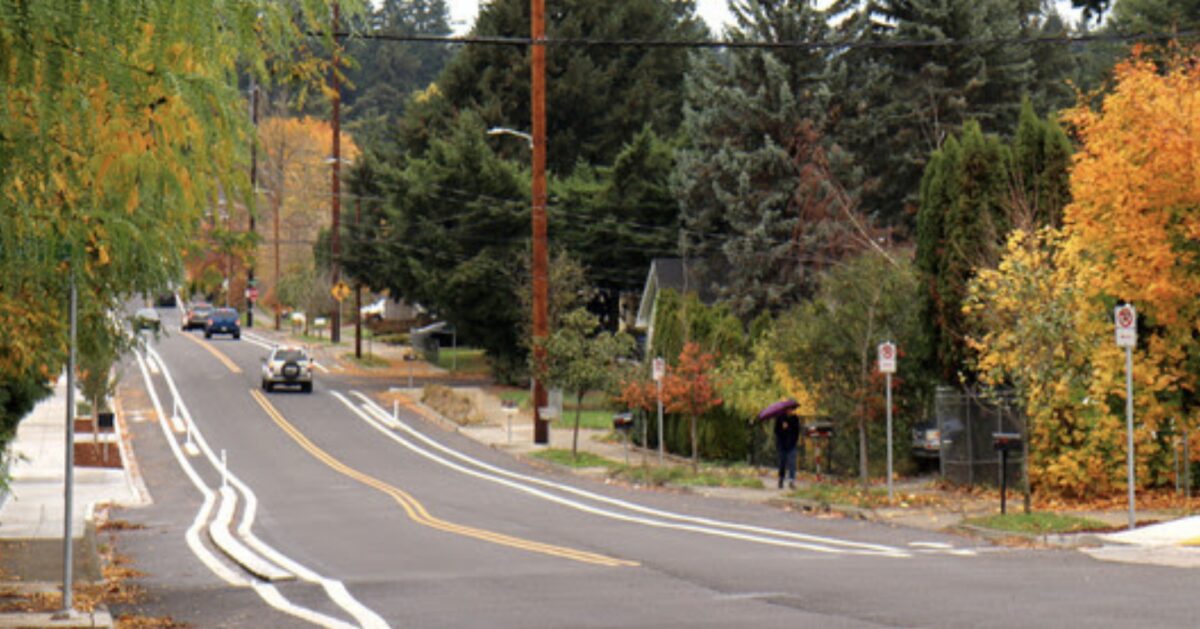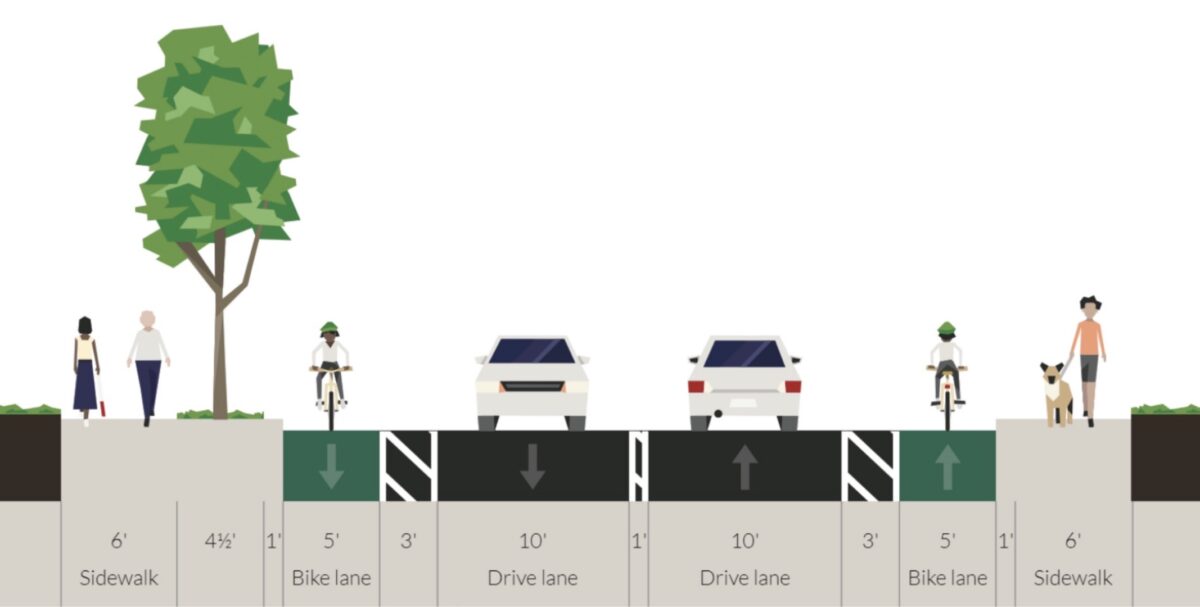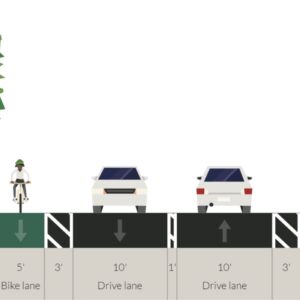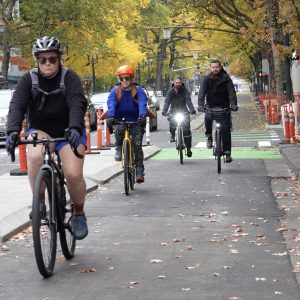
The Portland Bureau of Transportation announced today that they have “transformed” a 1.8 mile stretch of SE 136th Avenue between SE Division and Foster. After 18 months of construction and a $6.7 million investment, the road has gone from a crack-and-pothole filled mess with on-street parking on both sides, to a much more complete street.
Here’s what PBOT has done:
– 1.8 miles of street repaving
– 1.8 miles of continuous sidewalk on the west side of the street
– 3.6 miles of new protected bike lanes (1.8 mi in each direction)
– 48 new or upgraded ADA curb ramps
– 52 new street trees
– 6 new bioswales
– 1 rebuilt traffic signal (SE Division St. and SE 136th Ave)
– 1.8 miles of upgraded street lighting
The changes not only improve the experience of using 136th and open it up to safer cycling, they also help people connect to many destinations including three elementary schools and numerous parks. Bus users will also benefit from safer crossings to reach the Line 17 and 10 routes.
The bike only lanes are five-feet wide with a three-foot buffer. They are adjacent to 10-foot wide general purpose lanes.
Advertisement

PBOT has also added to connections to other parts of the network from the new bike lanes on 136th. The two new bikeways are protected bike lanes on SE Holgate from 136th to 130th to connect to the 130s Neighborhood Greenway, and a series of sharrows and signage on SE Center to connect to the 150s Neighborhood Greenway.
PBOT Commissioner Jo Ann Hardesty (an east Portland resident who wasn’t on council when the project was first designed and funded), said this project is another example of how the agency is directing investment toward the, “Historically neglected streets of East Portland.” Another part of the project Hardesty is excited about is that the prime contractor was a woman-owned firm and seven of the 11 subcontractors used are state-certified disadvantaged, minority-owned, women-owned, emerging small businesses.
I plan to roll out to see this project myself soon. I’m curious how they look and feel in real life. One reader shared with us via Twitter this morning that the bike lanes are filled with leaves and garbage bins and illegally parked cars. This is common across Portland when these curbside bike lanes are installed, but the problems typically improve over time.
Have you used 136th recently? What was your experience?









Thanks for reading.
BikePortland has served this community with independent community journalism since 2005. We rely on subscriptions from readers like you to survive. Your financial support is vital in keeping this valuable resource alive and well.
Please subscribe today to strengthen and expand our work.
I walked the stretch between Powell and Division a couple of weekends ago.. still no chance I’d ride out there. Too disconnected and too much speeding to trust the sporadic curbs.
I run from the house to Powell Butte and cross 136th multiple times a week. This all looks pretty nice to me. They still need to keep hammering people who feel they can park in the bike lanes (a lot of folks out this way sure seem to own a ton of cars). I’m glad the city did all this work even though I’ve yet to see anyone use any of this.
I rode it last night – bike lanes were filled with leaves and garbage bins 🙂
Rode it last Sunday – bike lanes were filled with leaves, garbage bins and illegally parked cars.
Otherwise it’s an improvement over what was there before. I’ve only used it to go from the Springwater to Holgate to access Powell Butte trails.
18 months? Where did that figure come from? The project has been on the books for over 25 years. Some of the improvements were built in 2010 such as the Bush crossing, some later in 2012-14 such as the retaining walls. It’s taken 11 years to construct it, not 18 months. And the price tag is closer to $18 million over that time.
3.6 miles of new protected bike lanes (1.8 mi in each direction)
1.8 miles of street repaving
1.8 miles of upgraded street lighting
Are the above statistics direct from PBOT? Doubling up the miles of protected bike lanes leaves a bad impression on how data is presented.
Was the street repaved in only one direction? Was the upgraded street lighting only in one direction?
Pixie…In response to your comment “Doubling up the miles of protected bike lanes leaves a bad impression on how data is presented.” This measurement used is very common in the transportation planning and engineering field as it help to communicate the true facility size of a project. Image the alternative, the old CRC project could have been say a “~2 mile long project” vs. a ~24+ lane mile project…
I think this is why using miles of PBLs alone can be a misleading number. A better metric would be miles of connected PBL network, in which case Portland has very few. Is 136th good? Sure. Is it connected to a safe network? Not even close. Is there a plan to prioritize a network at PBOT? I see no evidence of that.
I don’t understand. Where are delivery vehicles and friends supposed to park while visiting the homes along this road? I don’t live there, but this is becoming a serious issue in my neighborhood, NoPo, for a different reason – businesses and infill created without parking.
Delivery vehicles can park in the general travel lane and as drivers, we’ll just have to either wait, or drive around them. That’s exactly what happens when trucks park in the bike lane right? And as for friends parking? There is no right to public space, and using it to move people safely is a much more important use that storing private property. The best way to deal with these issues is to drive less and use other ways of getting around, or maybe plan ahead and give yourself time to park away from your destination and take a scooter or walk the last mile. These kind of planning inconveniences are common for people without cars, so I think it’s totally reasonable that the tables are turned more often. After all, we will only reach our safety, transportation and climate change goals if we start restricted car access which is a key element of reducing car use.
“The best way to deal with these issues is to drive less and use other ways of getting around”
Do tell us about those other ways JM. Tell us about the incredible bike facilities, sidewalk network and TriMet transit links in East Portland and how they conveniently connect people to local super markets, to their jobs in the Columbia Corridor, or even to parking on nearby side streets that don’t yet have sidewalks (and probably never will.)
Here’s an idea for one of your video expeditions: tell us about your entire trip from your home (with edits) on your electric bike to 136th and all the other routes and diversions you had to take in between on not-so-great streets that everyone else has to use. You can even use current bike boulevards and/or Powell.
oh come on David. I see what you’re doing here and you know that’s not what I’m about. I stated a fact: That we all need to use our cars less and use other modes more. Don’t try to frame me as someone who isn’t sympathetic to drivers or someone who doesn’t intimately understand the wide chasm in quality of bike facilities and access for non-drivers from one part of the city to the next.
Sounds like you’re trying to avoid the simple fact that it’s (past) time that we make it loud and clear that driving should be and is getting less convenient and that we must shift trips to other modes or we’re all going to die much sooner – either from traffic violence or from climate catastrophe. I’m tired of this game where folks think it’s unfair to even talk about driving less until every inch of the city has perfect bike facilities and transit service.
JM, you are a journalist who has taken a press release from PBOT and written it up as a story without first investigating if all of the PBOT statements are actually true or not. Then you add insult to injury by blaming local residents, most of whom are poor, for driving and parking their cars, without actually interviewing any of them. I’d say you aren’t doing your job very well.
I strongly disagree with you David.
Thanks for the feedback.
In my experience, many mostly-white active transportation activists have little interest in the lived experience of car-dependent poor people and often behave in a reactive and classist manner when their disinterest is challenged. As a tenant who lives in deeply-substandard housing and as a tenant organizer who has many years of direct experience with how our market housing system dehumanizes poor people, I care far more about what poor car drivers want than I care about what well-off, mostly-white, low-car people want.
yeah by definition, active transportation activists probably have little interest in car-dependent people, poor or not.
And to be clear, I actually wish David had challenged my views (that we need to be more direct about the need to drive less and increase our use of bikes/feet/transit and so on whenever possible). I love a good debate and am very open to changing how I think about things. But he hasn’t challenged me at all. He just changed the subject and then when I replied, he changed the subject again. He’s just created a criticism out of thin air because it gave him an opportunity to make his favorite points (similar to what you often do here, which you’ve admitted to in your role as a “devil’s advocate”). It’s tiresome really and too bad because you are both very smart and good people who I think could use your time on this site in a much more productive way (and to David’s credit he does very often already).
Soren is clearly smart, but I’ve given up on trying to understand their anti-private-housing-construction-but-pro-tenant angle, and I’ve tired of the consistent suggestion that everyone who disagrees with their idiosyncratic views is stupid and/or greedy.
This is a fabrication. I eschew ableist language:
absurd/ridiculous instead of crazy/nuts
incorrect/inaccurate instead of stupid/dumb
My position on greed is also far more nuanced. I don’t think a loanowner/homeowner who believes in trickle-down voodoo housing markets is greedy in the way a developer/speculator is greedy. However, I do believe that those who benefit from our housing market status quo have the privilege of being sanguine about continuing injustice and this can be seen in the willingness to see rearranging deck chairs on the housing crisis titanic as “progress”.
Do you care about poor people when it doesn’t align with your concern trolling about cars?
If you agree that
1. reduced VMT is important for safety & climate goals
2. bicycling is a potential means to replace car trips & reduce VMT
3. a protected bicycling network is a necessary condition for increased bicycling
then I wonder why you seem so indignant? Are you having a bad day?
This is a good, incremental step towards a protected bicycling network, the lack of which you point to as a reason why East Portlanders remain car dependent. Are you upset that PBOT did not simply build the entire network at once?
PBOT and the city took over this area partly in the 60s (as part of Pleasant Valley) and entirely since 1991. They have had 30 years to improve East Portland in general, and specifically 136th and the area around it. So yes, I am a bit “upset that PBOT did not simply build the entire network at once”, particularly as Multnomah County has found that this area pays a higher rate per unit of value than inner Portland, even though it is much poorer.
bbcc definition: “at once” = 30 years.
So you’re siding with someone complaining about parking as PBOT tries to build that network now? That’s akin to someone who has been starving for years refusing a meal on the grounds that it took so long to arrive. Eat, man! Would placing the interests of parking over bike infrastructure have gotten that network built sooner?
Tell me, how many of the neighbors on 136th bicycle?
I’m seeing an estimated 17-45 bicycle commuters in the census tract immediately west of 136th according to the 2017 ACS.
I believe a) those commuters should have access to safe facilities b) with safer facilities, that number will grow.
A typical smug JM remark about the poorest areas of Portland, be it in EP Cully, or NoPo. 136th is in the center of one of a HUD Qualified Census Tract (over 60% of households below the median Portland income), where nearly all public school children in the area qualify for free lunches, and one of the most racially diverse, with poor infrastructure connectivity – how else did you figure they got the funding to rebuild the street? Out of the goodness of PBOT’s heart? And then we get a really dumb set of remarks from an ignorant JM who has probably never willingly explored this area.
JM, people drive in these areas because they have no other reasonable choices – even with these improvements on 136th, local residents still cannot connect with other safe facilities to get where they want or need to go, and transit service is not only poor and infrequent, but it is not designed to get them where they want to go – almost no local residents work downtown.
Wow David. See my other reply in this thread. You’re extremely wrong about me. But go ahead and continue believing all that because it suits your own advocacy and inner narrative about what you want to believe about me. What’s unfortunate about your comments is that continuing to make excuses for people to continue driving at the same rates they currently do, only cements the current status quo of car supremacy – and its myriad negative externalities for lower-income people – even further.
And because it seems unclear to you, I have never and will never say everyone needs to stop driving. I do however, think it’s important to remind folks that more of us need to drive less as much as possible.
Could it be that you are projecting your insecurities (as an economically-comfortable person living in fantastically transportation rich inner portland) on poor people who have no other option than driving? Perhaps selling the minivan and “reminding” your low-car friends who drive might be a better way to embody change than “reminding” people in the numbers that they should “plan ahead” and/or “take a scooter” on high-crash network arterials to daycare/school, to the grocery store, or to a clinic.
Given the infinite complexities of the human mind and my existence as a white middle-aged, homeowning cis man, I’m open to almost possibility when analyzing my mind and the beliefs I hold. That being said, I just think you’re wrong here. I think you and David (at least in this thread) are so obsessed with seeing me a certain way (noticing that David specifically pointed out that I ride an e-bike and you mention my assumed wealth and car ownership) that it clouds your ability to have a productive discussion.
This is a larger problem IMO with a lot of folks these days. It feels like you are way too quick to judge me and throw out my ideas (and/or totally misread them) for no other reason than to flesh out the caricature you’ve built in your head about me, one that’s based on very superficial judgments because neither of you actually know me well at all.
And I have no plans to sell my minivan. Unlike you, I don’t see the mere ownership of a car as something to criticize or hold over people. I think we should look at the whole person and understand their needs and beliefs before rushing to judgments about them and/or projecting our own stuff onto them simply to push a narrative or play devil’s advocate.
The belief that transportation activists should be disinterested in car-dependent poor people because they have little to learn from them or because the have already determined what poor people need (based on upper class/college-educated “knowledge” of transportation systems) is the epitome of class- and race-based caricature.
My goal was to be provocative not because I want to troll you but because many car-dependent poor people do want better transportation alternatives (and not only sidewalks, better lighting, and marked crosswalks). They also want more of what inner Portlanders have in abundance — the safety, comfort, and dignity that comes from living in a neighborhood with abundant resources near their homes. One of the things I’ve learned as a white tenant organizer is that grocery stores, corner ships, preschools, drug stores, clinics etc. are transportation infrastructure. We can build all the bike lanes in East Portland we want, but without better access to basic resources most people will still drive by default (and I don’t blame them at all).
To provide some personal “narrative” color to the above critique: I still vividly remember when a fellow tenant cut short my “getting rid of parking helps poor people rhetoric” by explaining to me that parking was important to her family not because it was a convenience but because she was afraid to walk long distances to her home. Instead of categorically dismissing the resistance of poor people to more bike lanes or to more road diets it might be useful to better understand, and even directly address, the socio-economic roots of this distrust.
PS: The claim that you don’t believe ownership of a car is something to criticize while using language like “the current status quo of car supremacy” or, elsewhere, “the war on cars” is simply not credible. I think one of the huge cultural divides in this terminally dysfunctional society is that college educated white liberals have lost the ability to understand how they sound to people who aren’t in their epistemically-closed “education” class.
I did not mention wealth at all. I assumed that you are a loan owner with government-funded rent control (e.g. housing security) and that you do not struggle to afford basic necessities (e.g. utilities and food).
Jonathan is not the villain. You are being unkind to him because he cares and he will respond to you. PBOT, presumably, does not. Cars are wildly expensive. Poor people would have an easier life if they did not need to rely on them so much.
Thank you for all the responses. Some very good points were made. I am just trying to assimilate your vision of the future with fewer cars. I always make a point of commuting by bicycle when I can, but it seems like there are a lot of instances when that just doesn’t work. For instance, my wife and I are from big families. When we host a holiday feast many carloads come with their families from all over the surrounding area e.g. Longview and Cornelius, bearing gifts and hot dishes that could not all possibly be cooked in our oven at the same time or carried on public transportation. Also many are elderly and can’t walk very far. If all the on street parking is taken up for miles around by bike paths and the cars of residents of all the new buildings built without parking, where are our guests to park? I have to add that I don’t believe we will ever get rid of personal vehicles. They will all just go electric. They allow us to feel a freedom to drive to the coast range for a hike or visit a friend on a whim, for example. That we’re not just inmates in a work camp confined to our routes to work or school and back.
I own two cars. I have 3 kids (10, 16, and 18) and a wife who really get annoyed when I remind them we should be driving less. I am not living in some carfree bubble and I can very much relate to the driving culture and experience.
Again, I am not saying we are ready as a society to be completely carfree. I am saying we need to be much more responsible about our car use… which I actually call car abuse. Because that’s the problem: Too many people abuse the use of cars, and too many elected leaders and policymakers enable that abuse through bad policy and decisions about infrastructure.
“””If all the on street parking is taken up for miles around by bike paths and the cars of residents of all the new buildings built without parking, where are our guests to park? “””
Stop. This is not the scenario anywhere in Portland. I live very close to 136th. There is *no shortage* of on street parking anywhere out this way. Will someone have to walk a block to get to a house on 136th now? Maybe. Miles? No, never. Stop.
Take a look at google maps and street view. There was already no one parking along this stretch of 136th. I also see every house or apartment has a driveway with multiple spots and there are tons of side streets with ample street parking. If the area lacked parking before, this project didn’t make it worse in any way. If anything, legally allows delivery drivers to park in the bike lane, as they do all over, and make their delivery.
If one’s home is on a major roadway you should not expect on street parking in front of your house. People live on Cesar Chavez and 82nd don’t have parking in front of their homes.
The map is bizarre. It excludes the Springwater MUP, the PBLs (122nd to 136th) and BLs on Powell, and the TriMet upgrades on Division. Presumably it only includes PBOT projects.
No way those bike lanes are standard width. The buffer is nice, but they look to be about 3-4 ft max in many spots. They can’t even fit the bicycle symbol in them without getting in the gutter/curb.